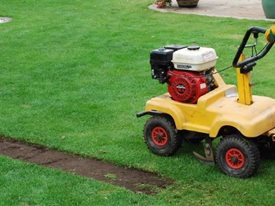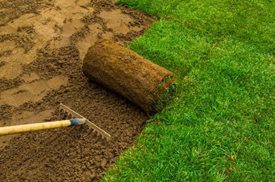First time laying turf? It’s something that even the most inexperienced gardener or landscaper can handle. Plan ahead, follow our simple instructions and take your time; if a new lawn is maintained correctly once laid, it’s a project that should only need doing once.
Tools required:
- Turf cutter or weed killer (if applicable)
- Long knife, hand saw or cutting spade to cut the turf
- Spade/Fork
- Wheelbarrow to move the turf rolls (optional)
- Standard rake
- Hose/watering can
- A second pair of hands to help (optional!)
Step 1 – How much turf and topsoil do you need?
 Use our Turf Calculator to work out how much turf is needed. We recommend adding 5% more rolls to the total so that you have enough for cutting and shaping.
Use our Turf Calculator to work out how much turf is needed. We recommend adding 5% more rolls to the total so that you have enough for cutting and shaping.- You need a base of good quality topsoil to lay turf at a minimum depth of 150mm; our Topsoil Calculator can help with that too if you need to buy some.
Important: Turf is a roll of living grass plants, so make sure all preparation work is complete before the turf arrives and with a convenient delivery date selected. Turf should be laid as soon as possible on the day of delivery in the spring/summer or the following day in the autumn/winter, at the latest.
Step 2 – Prepare the ground
 If the area to be turfed has an existing lawn down, apply a weed killer that kills grasses (at least 14 days before laying the turf) or remove it using a turf cutter – these can be hired. A manual turf cutter or spade can also be used.
If the area to be turfed has an existing lawn down, apply a weed killer that kills grasses (at least 14 days before laying the turf) or remove it using a turf cutter – these can be hired. A manual turf cutter or spade can also be used.- Next, the ground should be broken up, using a spade or fork, to a depth of 150-200mm. Stones, debris or weed roots should be removed at this point. You could use a rotavator for this step if working in a large area.
- Ideally, spread a turf and seeding topsoil to a minimum depth of 150mm.
Important: Weeds should be removed before using a rotavator to avoid working them into the ground or they may grow through the new turf!
Step 3 – Create a smooth, level surface
 Use a rake to level out the surface and then tread the area in several directions to lightly compact the soil. Never use a roller for this because you only want the ground to be firm, not solid.
Use a rake to level out the surface and then tread the area in several directions to lightly compact the soil. Never use a roller for this because you only want the ground to be firm, not solid.- Allow the area to settle for a few days before laying the turf and remove any weeds that germinate before you start to lay the turf.
- Water the prepared ground one or two days before the turf delivery, but don’t soak it too much.
Step 4 – Laying the new lawn
- Lightly rake the surface of the topsoil so that there is a fine layer of soil for the turf to lay on.
 To lay the next roll push the end tight into the short edge of the roll you’ve just laid (don’t pull the turf as it might tear); repeat this until you have completed the row, keeping the edges as close together as possible so there aren’t any gaps.
To lay the next roll push the end tight into the short edge of the roll you’ve just laid (don’t pull the turf as it might tear); repeat this until you have completed the row, keeping the edges as close together as possible so there aren’t any gaps.- Moisten the prepared soil prior to laying the turf on to it.
- Newly laid turf should not be walked on, if possible, until it is properly rooted, so start laying the turf at the corner furthest from you.
- If the edge of the lawn area isn’t straight, overhang the roll so that you can shape the edge with a knife later, then unroll.
- Gently firm down the turf using the back of the rake, to make sure it is in contact with the soil below.
- Repeat the above steps keeping the long and short edges tight against each other and lay the turf in a brick pattern so that the short ends aren’t in a line. Use your knife to cut the rolls that are placed at the end of each row.
Step 5 – Watering a new lawn
 Now that you’ve finished laying the lawn you need to water it thoroughly, making sure you pay particular attention to the edges which can dry out more quickly.
Now that you’ve finished laying the lawn you need to water it thoroughly, making sure you pay particular attention to the edges which can dry out more quickly.- If you’re not sure whether you’ve watered it enough, when you’ve first laid it you can gently lift a corner to check that the water is draining through to the soil underneath.
- If there are puddles of water on the lawn which don’t drain away, you are heavily overwatering.
- See our article ‘How often should a new lawn be watered’ for further advice.
For more information on how to look after a new lawn sign up to our newsletter.
 Use our
Use our  If the area to be turfed has an existing lawn down, apply a weed killer that kills grasses (at least 14 days before laying the turf) or remove it using a turf cutter – these can be hired. A manual turf cutter or spade can also be used.
If the area to be turfed has an existing lawn down, apply a weed killer that kills grasses (at least 14 days before laying the turf) or remove it using a turf cutter – these can be hired. A manual turf cutter or spade can also be used. Use a rake to level out the surface and then tread the area in several directions to lightly compact the soil. Never use a roller for this because you only want the ground to be firm, not solid.
Use a rake to level out the surface and then tread the area in several directions to lightly compact the soil. Never use a roller for this because you only want the ground to be firm, not solid. To lay the next roll push the end tight into the short edge of the roll you’ve just laid (don’t pull the turf as it might tear); repeat this until you have completed the row, keeping the edges as close together as possible so there aren’t any gaps.
To lay the next roll push the end tight into the short edge of the roll you’ve just laid (don’t pull the turf as it might tear); repeat this until you have completed the row, keeping the edges as close together as possible so there aren’t any gaps. Now that you’ve finished laying the lawn you need to water it thoroughly, making sure you pay particular attention to the edges which can dry out more quickly.
Now that you’ve finished laying the lawn you need to water it thoroughly, making sure you pay particular attention to the edges which can dry out more quickly.